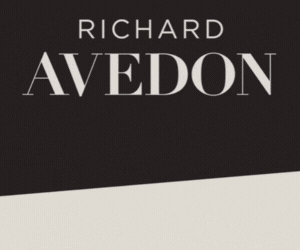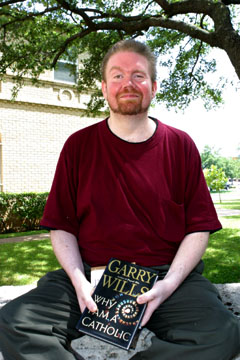 It must be the brand-new shoes, I told myself while standing at the lectern in front of a packed congregation at Dallas’ Holy Trinity Catholic Church. I had been selected from among the conversion students to serve as a lector at the same Holy Saturday service at which I was to receive my baptism, confirmation, and first communion. I was reading everyone’s favorite “family values” tale from the Old Testament — the story of God asking Abraham to kill his son Isaac to prove his faith.
It must be the brand-new shoes, I told myself while standing at the lectern in front of a packed congregation at Dallas’ Holy Trinity Catholic Church. I had been selected from among the conversion students to serve as a lector at the same Holy Saturday service at which I was to receive my baptism, confirmation, and first communion. I was reading everyone’s favorite “family values” tale from the Old Testament — the story of God asking Abraham to kill his son Isaac to prove his faith.
Another part of my brain wondered if the gay genes in my body were rebelling, punishing me with aching feet. Yep, that’s right — they picked the sodomite to read from Holy Scripture. This won’t surprise anyone familiar with Holy Trinity, which is located in the gay and lesbian neighborhood of Oak Lawn. This church is listed on national web sites for gay Christians as one of the more tolerant, even welcoming, parishes in the city. Their homosexual congregants are legion. (Just how gay is Holy Trinity? Well, the church choir is scheduled to perform a Cole Porter revue this month, so you be the judge.)
Much harder for most people than figuring out why the Catholic Church let me in, however, is figuring out why I wanted in. Have I lost my mind, you can see people wanting to ask me — have I not heard about the church’s gay-bashing tendencies? It’s not like they hide them under the communion wafers. As a gay man who’s been out to the world since I was 20, as a supporter of every item you can name on that infamous “gay agenda,” as a longtime critic of so many facets of organized religion, I could certainly have picked a better church. The Episcopalians made that gay dude a bishop. The Unitarians will hug anyone. And Dallas is home to the world’s largest non-denominational gay and lesbian church, the Metropolitan Community Church — I could have gone there and been safe among “my people.”
I admit, part of my attraction to the Catholic Church stems from surface things. I love the church’s pageantry and mysticism, the iconography — and the fact that the heroes of so many of the horror movies I adored as a child were cross-wielding men of God. Blame it on Peter Cushing.
But blame it also on my spiritual and free-thinking grandmother. Blame it on a host of Catholic theologians whose works I have read and Catholics with whom I have spent so many hours talking, who have so aptly described a faith that, for all of its flaws, is inherently human, tolerant, diverse, and, in the end, accepting of human imperfection.
Blame it on Jesus and the Sacred Heart. Sigh.
The big framed print of Jesus and the Sacred Heart hung in my grandmother’s small front room. Jesus and his bleeding ticker, aflame with a cross but ringed by painful nettles, is part of my earliest memories, welcoming — and disturbing — me each time I would visit, becoming part of my psyche long before any Christian church began trying to demonize me.
Eva Warner was my maternal grandmother, a church-going Methodist who, even after her death in 1979, held a legendary status in my family as an incredibly accepting and calming person. I remember her horn-rimmed glasses, a faint menthol cigarette smell, and the red plastic bottle of saccharine tablets she carried in her purse to sweeten the coffee and tea she drank. Eva, for one, would not have seen anything weird about me being gay and Catholic.
Despite her own middle-of-the-road Protestant religion, Eva was interested in many faiths. Buddhas and the Catholic Jesus shared space at her house. During her later years, she quietly widened her religious seeking, skipping church to stay home reading the Bible — and the Talmud, Edgar Cayce, and Norman Vincent Peale.
My parents chose not to baptize me in any faith, and I didn’t grow up as a churchgoer, but that didn’t make me an atheist. I always thought there was a higher creative power, always knew I would join some church, somewhere — even, as I grew older, when the attitudes of gay-bashing religious institutions pissed me off the most.
While I wandered through those years, trying to figure out what I believed and how I could get to sing in Jesus’ choir, other influences were also tunneling from within. I mean, how many people can claim Dracula and Mia Farrow as religious influences?
My mother is a big-time horror movie fan, and I grew up on a gluttonous diet of the stuff. Monster flicks from the British Hammer Films studios and those Edgar Allan Poe “adaptations” from American International were special favorites, which meant I absorbed a steady parade of blood-drinking, crucifixes, flesh wounds, resurrections from the dead, Satanism, and invocations of God. My first religious authority figure may have been the grand British character actor Peter Cushing, who wielded a mean cross against those luscious-but-deadly Brides of Dracula. T.S. Eliot once remarked of the satanic imagery in gay Catholic poet Charles Baudelaire’s work that it was so obsessed with “sin and redemption” that it couldn’t help but be a sideways tribute to Jesus. Ditto for horror movies with religious themes, I say.
But the grande dame of all horror films for me — the one that burrowed deeper into my skin than any other — was Rosemary’s Baby. I was as obsessed with Roman Polanski’s movie as I was with Ira Levin’s novel upon which it was based. At the age of 10, I could recite every line from the movie along with the actors — surely not a reassuring sight for my parents.
To refresh your memory, the lead character of Rosemary is a rather timid young woman who has been ostracized by her staunchly Roman Catholic clan because she married a non-Catholic. Abandoned by faith and family, she is befriended by a band of elderly occultists in a rotting New York brownstone who wish to make her their Mary for the incarnation of Satan into the world and who explicitly mimic Catholic rituals in their worship. As Stephen King has noted, the book and the movie function equally well as dark comedy: Look what happens to a good Catholic girl who strays from the flock — she gets knocked up by the devil, and on the night the Pope is holding Mass at Yankee Stadium, no less.
OK, you’re thinking — so he came to Catholicism through his grannie, a well-known Christian painting, and images from horror films — I can handle that. While you’re in that accepting frame of mind, let’s go ahead and deal with the real no-no: Jesus as a cutie.
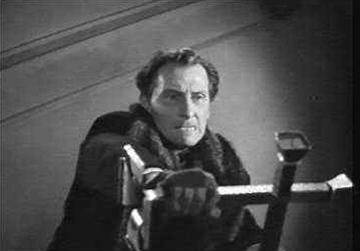 Truth is, He was probably my first crush. Face it, countless images of Jesus throughout the centuries show that same loving, doe-eyed, androgynous face — part of what motivated Mel Gibson to create what he hoped would be a manlier Jesus for The Passion of the Christ, to counteract what he saw as “effete” — read “faggy” — representations.
Truth is, He was probably my first crush. Face it, countless images of Jesus throughout the centuries show that same loving, doe-eyed, androgynous face — part of what motivated Mel Gibson to create what he hoped would be a manlier Jesus for The Passion of the Christ, to counteract what he saw as “effete” — read “faggy” — representations.
It’s not surprising that the Catholic Church attracts so many gay men; it’s more shocking that the whole institution isn’t pinker than a Euless trailer park flamingo. Jesus represents the perfect boyfriend — handsome, frequently shirtless, and willing to forgive pretty much anything. If Christ had an ad on outpersonals.com, the hits would crash the system. Surely Catholic schoolgirls have had the same — though suppressed — feelings about Sweet Jesus through the centuries.
Before you cry blasphemy, think about it. The Catholic Church has a long-entrenched sense of the erotic. The great medieval mystics, most of whom have been canonized as saints and doctors in the church, wrote vividly about it. Bernard of Clairveaux referred to the church altar as a marriage bed where the relationship between Jesus and the worshipping soul is consummated. One of Teresa of Avila’s most famous visions involve her, helpless and writhing with ecstasy, repeatedly penetrated by an angel’s golden spear. (“The pain was so great that it caused me to utter several moans,” she writes, “and yet so exceeding sweet is this greatest of pains that it is impossible to desire to be rid of it.”)
All of these visionaries helped me see Catholicism as something more than a big tough nun telling boys and girls alike to keep their legs crossed. The dreamy, sensual religious images didn’t make me decide to become a Catholic. They made the idea seem possible, yes. But it took more than that to grow my faith.
My religious journey has been largely an internal one — no pilgrimages, no grand revelatory moments, just a gradually dawning realization that I had a romantic and ironic sensibility that fit in well with a certain viewpoint espoused by Catholic writers like Flannery O’Connor and Oscar Wilde. Considering my love for the mystical, the macabre, the ceremonial, all the signs pointed toward me choosing Catholicism. The question became: Could I resolve my pull toward this beautiful liturgy with the church’s teachings on human sexuality?
Eventually, over the last three years, I found authors who helped me realize that I didn’t have to agree with everything the church teaches in order to become a member. They were the ones who convinced me to make this leap.
In order to exist comfortably as a thinking Catholic, you have to appreciate irony, paradox, and contradiction. The Catholic writer F. Scott Fitzgerald summed it up nicely with his famous phrase, “The mark of true intelligence is the ability to hold two diametrically opposite views in your mind at the same time and still function.” Only those who see the internal tensions of the church as frustrating and fascinating should tread here: The Catholic hierarchy spouts homophobic rhetoric, but there is near-universal agreement that its ranks contain more gay men than any other denomination. The church has barely entered the 20th century where women are concerned, yet it celebrates the feminine aspect of God like no other Western faith: Many communities throughout the world revere the Blessed Virgin with as much intensity and respect as they accord her son. The church brass opposed modernizing theories of astronomy and the printing press, yet European Catholicism has produced some of the most innovative thinkers in literature, theater, and the visual arts.
I recognize a kind of cynical compassion, a gorgeous misanthropy, in Catholicism. Two of my most revered Catholic-bred artists — O’Connor and the filmmaker Robert Altman — have perfected the “human comedy” of the Catholic sensibility, with its tough-love appreciation for the lost, the deluded, the doomed, and the clueless. Original sin is, for them, a bottomless source of motivation that everyone draws from. Similarly, Stephen Colbert — arguably the most prominent satirist in America today — wasn’t kidding when he appeared on his show with the ashen cross on his forehead this past Ash Wednesday. He takes his Catholic faith seriously but sees no conflict in mercilessly skewering the church’s vices. If this makes no sense to you, then Catholicism probably ain’t your cuppa vino.
And as it happens, one of the essential tools in the kit for gay survival is a fine sense of the absurd, though a fellow can only stretch that so far. Indeed, I’ve often said that being gay isn’t that hard — it’s the idiots who get you all stressed out.
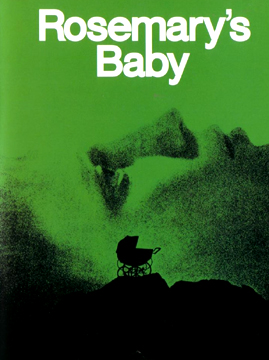 That crowd was in rare form during the 2004 U.S. presidential campaign. I was immersing myself in church history and mystical theology while watching Catholic candidate John Kerry position himself as one of the most accessible political punching bags in recent history. The apogee of absurdity, for me, was when Catholic conservatives declared that Kerry was “a hypocrite” because he said that he would not make policy decisions based on his Catholic beliefs. His reasoning was based on the shocking fact that America also contains many non-Catholics.
That crowd was in rare form during the 2004 U.S. presidential campaign. I was immersing myself in church history and mystical theology while watching Catholic candidate John Kerry position himself as one of the most accessible political punching bags in recent history. The apogee of absurdity, for me, was when Catholic conservatives declared that Kerry was “a hypocrite” because he said that he would not make policy decisions based on his Catholic beliefs. His reasoning was based on the shocking fact that America also contains many non-Catholics.
This was a mob that I was considering joining, and it left a taste in my mouth like licking an ashtray. Self-proclaimed Christians who get some kind of sick kick from denying couples they’ve never even met things like power of medical attorney and inheritance rights — these are the 21st-century Pharisees incarnate. I was not sure if I could continue honoring my irrational pull to the church if it meant being dragged into the company of these clowns.
And then I discovered two writers who changed my life. First was the openly gay British ex-Dominican priest James Allison, who refers to his books as “Catholic fish flavored with a little gay sauce.” One of his primary themes is the idea that every era and every society needs its scapegoats — and this time around it just happens to be homosexuals’ turn. And, Allison says, it is important for gay and lesbian Catholics — while working for a more enlightened society — to forgive the church as they have been forgiven by Jesus for the same propensity toward persecution.
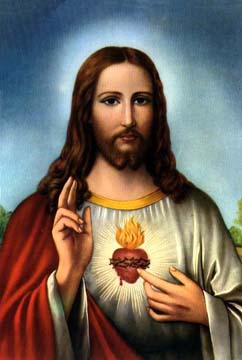 For me, the prospect of forgiving the Vatican — which has scarred and alienated so many gays based on admirable if overreaching lessons about the primacy of human life — represented an intriguing challenge. It also brought a chance for salvation from a life of intensifying bitterness toward people who despise and wish to marginalize me for very silly reasons. I have never wanted to be swallowed up by the gay ghetto, although living and working in an exclusive sea of heterosexuals can be a drag, too. Perhaps becoming a Catholic would lead me to my ultimate goal of being comfortable in both worlds, beholden to neither. But that forgiveness hill looked like one tall fucker to climb.
For me, the prospect of forgiving the Vatican — which has scarred and alienated so many gays based on admirable if overreaching lessons about the primacy of human life — represented an intriguing challenge. It also brought a chance for salvation from a life of intensifying bitterness toward people who despise and wish to marginalize me for very silly reasons. I have never wanted to be swallowed up by the gay ghetto, although living and working in an exclusive sea of heterosexuals can be a drag, too. Perhaps becoming a Catholic would lead me to my ultimate goal of being comfortable in both worlds, beholden to neither. But that forgiveness hill looked like one tall fucker to climb.
And then I encountered the Pulitzer Prize-winning historian and Catholic critic Garry Wills, who has since become something of a personal hero. Wills — who is straight — is notorious in church circles as the author of Papal Sin, a devastating critique of Vatican authoritarianism. From the reshuffling of pedophile priests to the demonization of gays to the subordination of women in its administrative and liturgical affairs, Wills writes with eloquence and efficiency about what he considers the arrogance, disconnectedness, and even duplicity emanating from Rome on certain issues.
In his most recent book, What Jesus Meant, Wills recounts the actions of a Catholic bishop in San Diego who forbade Christian burial to an openly gay man. “Is there any doubt where Jesus would have stood?” Wills wrote. “He would have stood with the gay man, not his haters.”
Wills is full of contradictions — a rosary-praying renegade, a progressive who firmly believes in end-of-times prophecies, a liberal who pushes for a new appreciation of church fathers like St. Augustine. He is the kind of thinker I can stand proudly with in Catholic communion.
Catholic thinkers like Wills and Allison helped me see that the condemnation of homosexuality is one of the least defensible religious conservative views. It’s based on a cherry-picking of anti-gay codes in Leviticus from the Old Testament and the letters of Paul from the New — ancient cleanliness regulations that legitimize conservatives’ squeamishness at the thought of boys kissing boys. Why haven’t the Concerned Women for America campaigned for laws to quarantine women during their menstrual periods? That would be as biblically correct as anti-gay marriage amendments.
I’ll give the Catholic Church a nod for consistency, though—they don’t want heteros to have much more fun than homos in bed. Simplistically put, the church teaches that anything that stands in the way of the creation of life is standing in God’s way. And so homosexuality is merely one sin in a long list that includes masturbation, birth control, and abortion. Catholic positions against war, poverty, the death penalty, and euthanasia also hover within this arena of the inherent dignity of all human life. The dirty secret of conservative Catholics in America is that when they support gratuitous U.S. military adventures and capital punishment, when they privately use contraceptive methods and publicly cut social services to the poor — hell, when they just jack off — they’re as much the sinner as when we gays do the nasty with the ones we love. Yet somehow, they expect homosexuals to carry a greater burden of guilt and shame.
Once again, the Catholic contradiction: Humans are fallen creatures, susceptible to all the usual vices, but human life is uniquely valuable in its potential. I like that approach, even if it’s not always practical when the rubber hits the road. The Catholic Church conjures a vision of the world as a democracy of sin—it is egalitarian in its pronouncements of corrupt human nature. And although the Vatican and Pope Benedict might desire to obfuscate this matter, they are very much included in this scenario. If the billion-dollar pedophilia scandals that have brought the church to its knees can be said to have any useful side effect, it is to remind the faithful that the Vatican is only human, and therefore sinful. If sin is understood by one Catholic definition as “a failure to love,” then Pope Benedict is sinning every time he declares homosexuality “an intrinsic moral evil.”
Believe me, I’m not holding my breath expecting the church to change its teachings on human sexuality during my lifetime. But Catholic attitudes are never easy to predict. Spain, one of the most Catholic countries on the planet, has also become one of the handful to legalize gay marriage. Heavily Catholic Massachusetts was the first U.S. state to approve homo nuptials. Some think Ireland will soon join the list. It’s just one of those cool Catholic paradoxes.
So there I was, the newly minted and very conflicted gay Catholic, reading to the congregation the story of a very stern and bloody god indeed. It forced me to wonder if God would ask me to kill a special part of myself — my capacity for loving another man — in order to prove my faith.
It occurred to me that the main point of the story might not be that Abraham was willing to cut his child’s throat, but that God stopped him from doing it. The story illustrates a God that does not require sacrifice — especially of one’s fullest humanity — in order to prove allegiance. I can let myself live whole, and that includes my sexuality.
To me, it’s all about the formidable but alluring task of trying to snatch some sense of compassion, wisdom, and creativity from the teachings of Christ. And the Catholic Church is the crucible that offers, to my mind, the purest, most visceral, most awe-inspiring recognition of his life, work, and death. I have no doubt that Jesus is catholic, but again note the lower-case “c” — the universal promise that somewhere within us resides the capacity to forgive and to love unconditionally. He is the great equalizer, bringing together the unlikeliest of bedfellows in common humility.
Somewhere in the eternal communion of Catholic souls, Pope John Paul II and Andy Warhol are chatting it up. Bet they’re having a helluva conversation.



